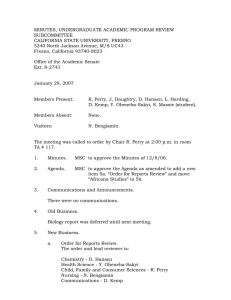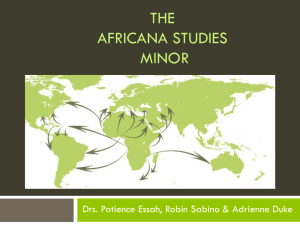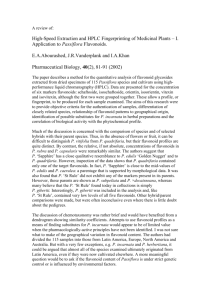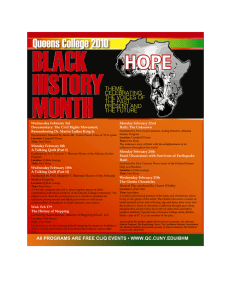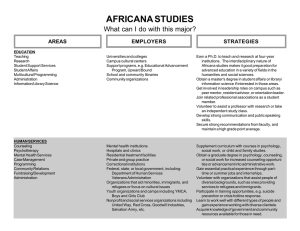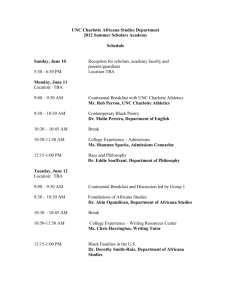Document 13309154
advertisement
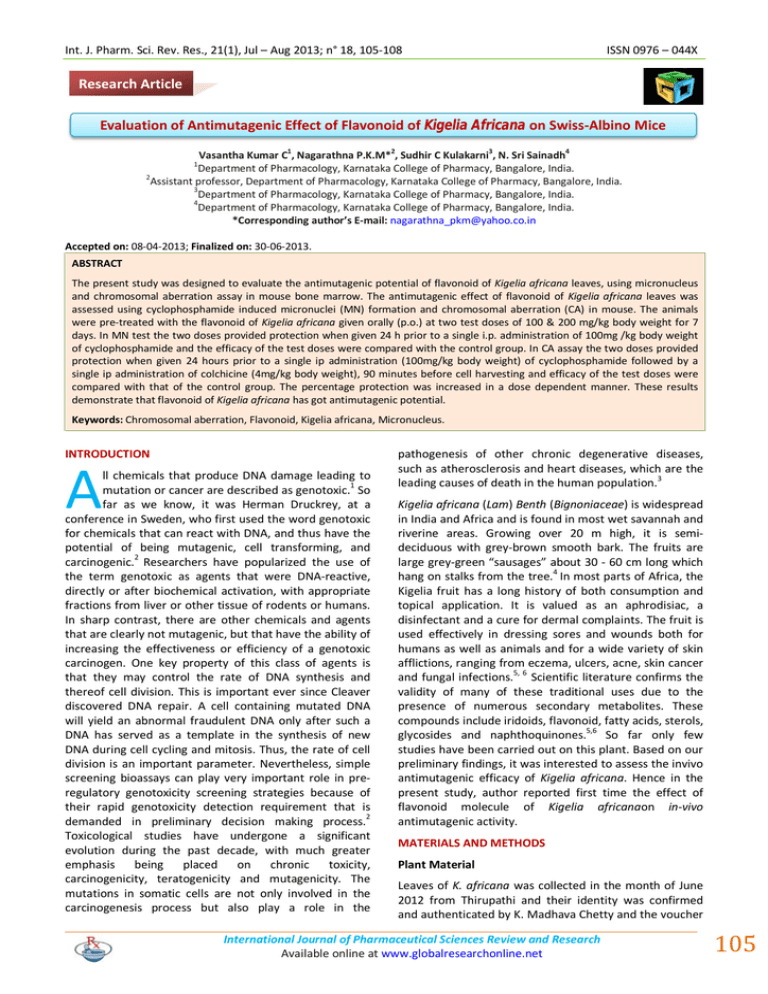
Int. J. Pharm. Sci. Rev. Res., 21(1), Jul – Aug 2013; n° 18, 105-108 ISSN 0976 – 044X Research Article Evaluation of Antimutagenic Effect of Flavonoid of Kigelia Africana on Swiss-Albino Mice 1 2 3 4 Vasantha Kumar C , Nagarathna P.K.M* , Sudhir C Kulakarni , N. Sri Sainadh Department of Pharmacology, Karnataka College of Pharmacy, Bangalore, India. 2 Assistant professor, Department of Pharmacology, Karnataka College of Pharmacy, Bangalore, India. 3 Department of Pharmacology, Karnataka College of Pharmacy, Bangalore, India. 4 Department of Pharmacology, Karnataka College of Pharmacy, Bangalore, India. *Corresponding author’s E-mail: nagarathna_pkm@yahoo.co.in 1 Accepted on: 08-04-2013; Finalized on: 30-06-2013. ABSTRACT The present study was designed to evaluate the antimutagenic potential of flavonoid of Kigelia africana leaves, using micronucleus and chromosomal aberration assay in mouse bone marrow. The antimutagenic effect of flavonoid of Kigelia africana leaves was assessed using cyclophosphamide induced micronuclei (MN) formation and chromosomal aberration (CA) in mouse. The animals were pre-treated with the flavonoid of Kigelia africana given orally (p.o.) at two test doses of 100 & 200 mg/kg body weight for 7 days. In MN test the two doses provided protection when given 24 h prior to a single i.p. administration of 100mg /kg body weight of cyclophosphamide and the efficacy of the test doses were compared with the control group. In CA assay the two doses provided protection when given 24 hours prior to a single ip administration (100mg/kg body weight) of cyclophosphamide followed by a single ip administration of colchicine (4mg/kg body weight), 90 minutes before cell harvesting and efficacy of the test doses were compared with that of the control group. The percentage protection was increased in a dose dependent manner. These results demonstrate that flavonoid of Kigelia africana has got antimutagenic potential. Keywords: Chromosomal aberration, Flavonoid, Kigelia africana, Micronucleus. INTRODUCTION A ll chemicals that produce DNA damage leading to mutation or cancer are described as genotoxic.1 So far as we know, it was Herman Druckrey, at a conference in Sweden, who first used the word genotoxic for chemicals that can react with DNA, and thus have the potential of being mutagenic, cell transforming, and carcinogenic.2 Researchers have popularized the use of the term genotoxic as agents that were DNA-reactive, directly or after biochemical activation, with appropriate fractions from liver or other tissue of rodents or humans. In sharp contrast, there are other chemicals and agents that are clearly not mutagenic, but that have the ability of increasing the effectiveness or efficiency of a genotoxic carcinogen. One key property of this class of agents is that they may control the rate of DNA synthesis and thereof cell division. This is important ever since Cleaver discovered DNA repair. A cell containing mutated DNA will yield an abnormal fraudulent DNA only after such a DNA has served as a template in the synthesis of new DNA during cell cycling and mitosis. Thus, the rate of cell division is an important parameter. Nevertheless, simple screening bioassays can play very important role in preregulatory genotoxicity screening strategies because of their rapid genotoxicity detection requirement that is 2 demanded in preliminary decision making process. Toxicological studies have undergone a significant evolution during the past decade, with much greater emphasis being placed on chronic toxicity, carcinogenicity, teratogenicity and mutagenicity. The mutations in somatic cells are not only involved in the carcinogenesis process but also play a role in the pathogenesis of other chronic degenerative diseases, such as atherosclerosis and heart diseases, which are the leading causes of death in the human population.3 Kigelia africana (Lam) Benth (Bignoniaceae) is widespread in India and Africa and is found in most wet savannah and riverine areas. Growing over 20 m high, it is semideciduous with grey-brown smooth bark. The fruits are large grey-green “sausages” about 30 - 60 cm long which hang on stalks from the tree.4 In most parts of Africa, the Kigelia fruit has a long history of both consumption and topical application. It is valued as an aphrodisiac, a disinfectant and a cure for dermal complaints. The fruit is used effectively in dressing sores and wounds both for humans as well as animals and for a wide variety of skin afflictions, ranging from eczema, ulcers, acne, skin cancer and fungal infections.5, 6 Scientific literature confirms the validity of many of these traditional uses due to the presence of numerous secondary metabolites. These compounds include iridoids, flavonoid, fatty acids, sterols, glycosides and naphthoquinones.5,6 So far only few studies have been carried out on this plant. Based on our preliminary findings, it was interested to assess the invivo antimutagenic efficacy of Kigelia africana. Hence in the present study, author reported first time the effect of flavonoid molecule of Kigelia africanaon in-vivo antimutagenic activity. MATERIALS AND METHODS Plant Material Leaves of K. africana was collected in the month of June 2012 from Thirupathi and their identity was confirmed and authenticated by K. Madhava Chetty and the voucher International Journal of Pharmaceutical Sciences Review and Research Available online at www.globalresearchonline.net 105 Int. J. Pharm. Sci. Rev. Res., 21(1), Jul – Aug 2013; n° 18, 105-108 specimen was deposited in the Department of Pharmacology, Karnataka College of Pharmacy, Bangalore India. The shade dried healthy leaves were powdered separately using mechanical grinder and then passed through sieve in order to maintain uniform powder size. Preparation of Extracts About 250 g of dry leaf powder was extracted using methanol solution in soxhlet apparatus. After about 2 h, the materials were concentrated by evaporation. The concentrated extract was shade dried to remove the solvent for further use. The yield of extract was calculated and stored for further use. The concentrated methanolic extract was then subjected to column chromatography, from which a flavonoid was isolated and it was confirmed through spectroscopy and structural elucidation. Experimental animals and treatment Eight to ten weeks old Swiss albino mice of either sex, weighing 25-30 g maintained under standard environmental conditions (25 ±2°C, relative humidity 45 ± 10%, light and dark cycle of 12 h) and fed with standard pellet diet and water ad libitum, were used for the present study. The experimental protocol, which is in accordance with the OECD (Organization of Environmental Carcinogen Detection) guidelines No.470 and WHO guidelines for mutagenicity studies in animals, was approved by the Institutional Animal Ethics Committee before starting the experiments. The animals were divided into five groups consisting of six animals each. Group one served as normal control, group two was treated with clastogen, cyclophosphamide 100mg/kg, i.p. and bone marrow was collected after 24 h of clastogen administration. Group three was treated with K.africana (200 mg/kg, p.o.) for seven days. Groups four and five were treated with Flavonoid of K.africana200 mg/kg, p.o. and 100 mg/kg, p.o. respectivelyfor seven days followed by Cyclophosphamide as a challenge. The dose for mice was calculated based on LD50 (2000mg/kg) values of K.africana. On seventh day, bone marrow was collected at 24h after clastogen administration, respectively. Chromosomal aberrations test ISSN 0976 – 044X one ml of 5%bovine albumin in phosphate buffered saline (pH 7.2). The cell suspension was centrifuged (1000 rpm for 5 min) and the smears were prepared from the pellet on chemically cleaned glass slides and stained with MayGrunwald’s and followed by Giemsa stain. The smears were analysed under oil immersion using Labomed Model Digi 2 microscope for the presence of micronuclei (MN) in polychromatic erythrocytes (PCE) and normochromatic erythrocytes (NCE). P/N (Polychromatic erythrocyte/ Normochromatic erythrocyte) ratio was determined by counting a total of about 500 erythrocytes per animal and 2000 erythrocytes were examined for the presence of micronuclei. RESULTS Chromosomal aberrations test As shown from Table 1 and figure 1 & 2, there was a statistically significant increase in chromosomal aberrations in response to cyclophosphamide (100 mg/kg). Flavonoid of K.africana significantly inhibited the frequency of various chromosomal aberrations and the decrease in mitotic index induced by clastogen. Figure 1: Total aberrations of different groups in Chromosomal aberration test 7 On seventh day, each animal was injected with 0.04% colchicine in a dose of 4mg/kg i.p, 90 min prior to death, for mitotic arrest. The bone marrow was aspirated from femur and tibia into suspending medium 0.075 M KCl, centrifuged and supernatant was discarded. The pellet was mixed with fixative (3:1, methanol: acetic acid) and then centrifuged. The preparation was given two changes of fixative and smears were prepared. The slides were flame-dried and stained with 10% Giemsa at pH 6.8 for 15-20 min. Smears were screened for different types of chromosomal abnormalities-rings, breaks, exchanges and minute. 8 Bone Marrow Micronucleus Assay Figure 2: Mitotic index of Chromosomal aberration test different groups in On seventh day, the animals were anesthetized and the bone marrow was aspirated from femur and tibia into International Journal of Pharmaceutical Sciences Review and Research Available online at www.globalresearchonline.net 106 Int. J. Pharm. Sci. Rev. Res., 21(1), Jul – Aug 2013; n° 18, 105-108 ISSN 0976 – 044X Table1: Effect of flavonoid of K.africana on chromosomal aberrations and mitotic index Types of aberrations Rings Exchanges Breaks minute Total number of aberrations Mitotic index Normal 1.00±0.26 0.667±0.33 0.0±0.0 0.67±0.33 2.33±0.42 4.33±0.71 CYP treated 5.16±0.54 2.00±0.36 4.67±0.71 4.50±0.62 16.33±0.76 1.83±0.31 KA (200 mg/kg) alone 1.00±0.45 0.83±0.31 1.67±0.56 0.83±0.31 4.33±0.56*** 3.33±0.50 KA (200 mg/kg) 2.50±0.76 1.33±0.42 2.17±0.65 1.50±0.34 6.17±0.79*** 2.50±0.43 Groups ns ns KA (100 mg/kg) 1.00±0.26 0.67±0.33 0.0±0.0 0.67±0.33 2.33±0.42*** 4.67±0.56** Values are expressed as MEAN±SD n=6 ***p<0.0001, ** p<0.001, ns=non-significant; when compared to CYP control group CYPCyclophosphamide, KA-Kigelia africana Table 2: Effect of flavonoid of K.africana after 24 h of clastogenic challenge Sl. No Groups PCE MNPCE %MNPCE±SEM NCE MNNCE %MNNCE P/N RATIO 1 Control 6033 28 0.46±0.05 6048 15 0.24±0.042 0.91±0.007 2 CYP Treated 6109 162 2.58±0.055 6045 54 0.88±0.056 0.63±0.010 3 KA(200mg/kg) alone 6035 61 1.01±0.059*** 6053 26 0.42±0.048*** 0.85±0.010*** 4 KA(200mg/kg)+CYP 6039 117 1.90±0.072*** 6020 38 0.62±0.032** 0.76±0.013*** 5 KA(100mg/kg)+CYP 6060 35 0.57±0.030*** 6025 19 0.31±0.059*** 0.98±0.011*** ** Values Are Expressed as Mean ± SEM, n=6, P<0.001, Cyclophosphamide *** P<0.0001 when Compared with CYP treated Group KA- Kigelia africana CYP- Figure 5: %P/N Micronucleus test Figure 3: %MNPCE of different groups in Micronucleus test Figure 4: %MNNCE of different groups in Micronucleus test Ratio of different groups in DISCUSSION Flavonoids act as an important class of antimutagens and anticarcinogens with high potential. Distinct structure activity relationship were detected when 56 flavonoids, 32 coumarins, 5 naphthoquinones and 12 anthraquinones were tested for their antimutagenic potencies, with respect to mutagenesis induced by 2nitrofluoro 3-nitro fluoranthene and 1-nitropyrene in S. typhimurium TA98. Among flavonoids, all flavones and many flavonoids with phenolic hydroxyl group like leuteolin, kaempherol etc., exerted antimutagenicity chalcones and dihydrochaleones were potent antimutagens.9 A number of known flavonoids including flavonoid glycosides and isoflavones were reported to possess significant antimutagenic activity. Citrus juice flavonoids are reported to possess anticarcinogenic and antimutagenic properties.10 Heo et al. (1992) tested 14 International Journal of Pharmaceutical Sciences Review and Research Available online at www.globalresearchonline.net 107 Int. J. Pharm. Sci. Rev. Res., 21(1), Jul – Aug 2013; n° 18, 105-108 flavonoids including flavones and flavonol derivatives for their antimutagenic effect against induction of micronuclei by benzo[α]pyrene (Bap) in polychromatic 11 erythrocytes (PCEs) of mice. In the Chromosomal aberration test, the administration of flavonoid of Kigelia africana at the dose of 100 and 200mg/kg body weight prior to the administration of cyclophosphamide have significantly prevented the chromosomal aberrations in dose dependent manner. The different types of chromosomal aberration such as chromatid rings, chromatid exchanges, chromatid breaks and minutes were prevented in challenge (Kigelia africana + cyclophosphamide) group as compared to control (cyclophosphamide) group. The % protection was increased in dose dependent manner. These results showed that flavonoid of Kigelia africana exhibited effective degree of antimutagenic activity. The micronucleus study showed that the administration of isolated pure compound of Kigelia africana at the dose of 100 and 200 mg/kg body weight prior to the administration of cyclophosphamide have significantly inhibited the micronucleus formation in the erythrocytes. CONCLUSION Plants having flavonoids has showed antimutagenic activity and therefore conducted study on flavonoid of Kigelia africana for its antimutagenicity. By the results obtained, it is confirmed that, flavonoid of Kigelia africana caused antimutagenicity in micronucleus and chromosomal aberration tests in bone marrow cells of mice. Although a variety of work has been done to explore the various potential of the different parts of Kigelia africana tree, but very few works are reported on the leaves of Kigelia africana. Thus, the present study on leaves of Kigelia africanawill provide a lot of scope for further research in this regard and isolation of chemicals from it may lead to the production of a variety of potent drugs. ISSN 0976 – 044X REFERENCES 1. Meera Sumanth, G. Nagarjuna Chowdary, Antimutagenic activity of aqueous extract of Momordica charantia, International Journal for Biotechnology and Molecular Biology Research, 1(4), 2010, 42-46. 2. Tomáš BARTOŠ, Study of Ecotoxicological Properties Using Screening Genotoxicity Bioassays, Masaryk University, Faculty of Science, Brno, Czech Republic, 2007, 13. 3. De Flora S, Izzotti A, Mutagenesis and Cardiovascular diseases: molecular mechanisms, risk factors, and protective factors, Mut. Res, 621 (e.g. 2), 2007, 5-17. 4. Kigelia Africana, http://en.wikipedia.org/wiki/kigelia (accessed November 2012). 5. O. M. Grace, M. E. Light, K. L. Lindsey, D. A. Moholland, J. V, Staden, A. K. Jager, Antibacterial Activity and Isolation of Active Compounds from Fruit of the Traditional African Medicinal Tree Kigelia Africana, South African Journal of Botany, 66(2), 2002, 220-222. 6. A. G. Olatunji, O. Atolani, Comprehensive Scientific Demystification of Kigelia africana: A Review, African Journal of Pure and Applied Chemistry, 3(9), 2009, 158164. 7. Goncalves da Silva RM, Sousa NC, Graf U, Spano MA, Antigenotoxic effects of Mandevilla velutina (Gentianales, Apocynaceae) crude extract on cyclophosphamideinduced micronuclei in Swiss mice and urethane-induced somatic mutation and recombination in Drosophila melanogaster, Genet. Mol. Biol. 31, 2008, 751-758. 8. Hayashi M, Tice RR, Macgregor JT, Aderson D, Blakey DH, In vivo rodent erythrocyte micronucleus assay, Mut. Res, 312, 1994, 293-304. 9. Edenharder, R. and X. Tang, Inhibition of mutagenicity of 2-nitrofluorene, 3-nitrofluoranthene 1-nitrtopyrene by flavonoids, coumarin, quinones other phenolic compounds, Food Chem. Toxicol., 1997, 357-372. the and and 35, 10. Calomme, M., L. Peters, A. Vlitinck, D. Vandenberghe, Inhibition of bacterial mutagenesis by citrus flavonoids, Planta Med, 62, 1996, 222-226. 11. Heo, M.Y., K.S. Yu, K.H. Kim, H.P. Kim, W.W. Au, Anticlastogenic effect of flavonoids against mutageninduced micronuclei in mice, Mutat. Res, 284, 1992, 243249. Source of Support: Nil, Conflict of Interest: None. International Journal of Pharmaceutical Sciences Review and Research Available online at www.globalresearchonline.net 108
